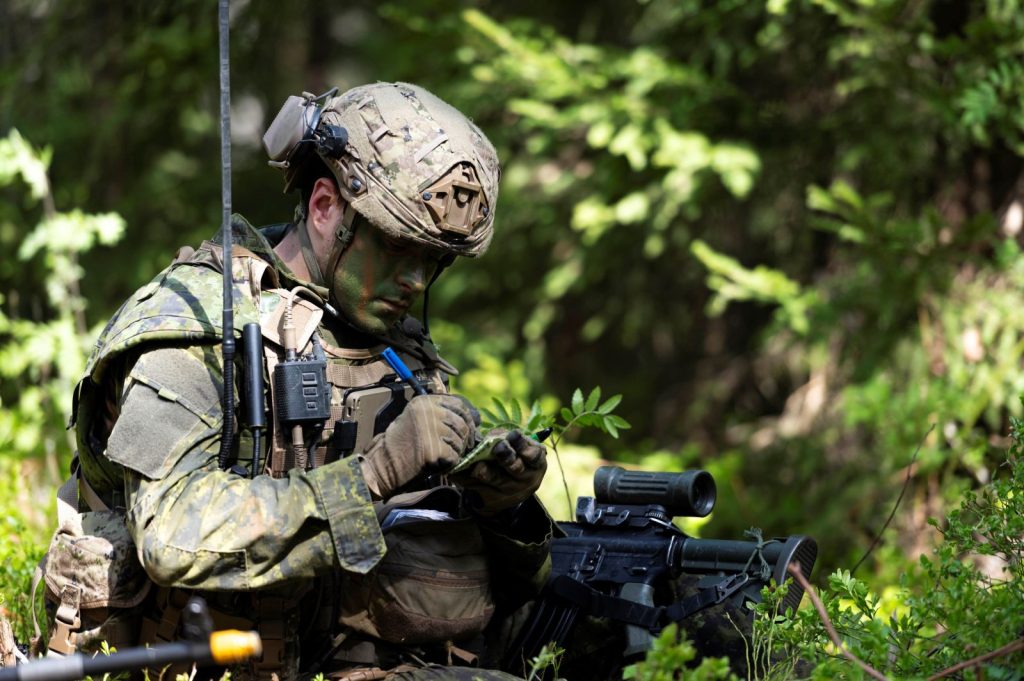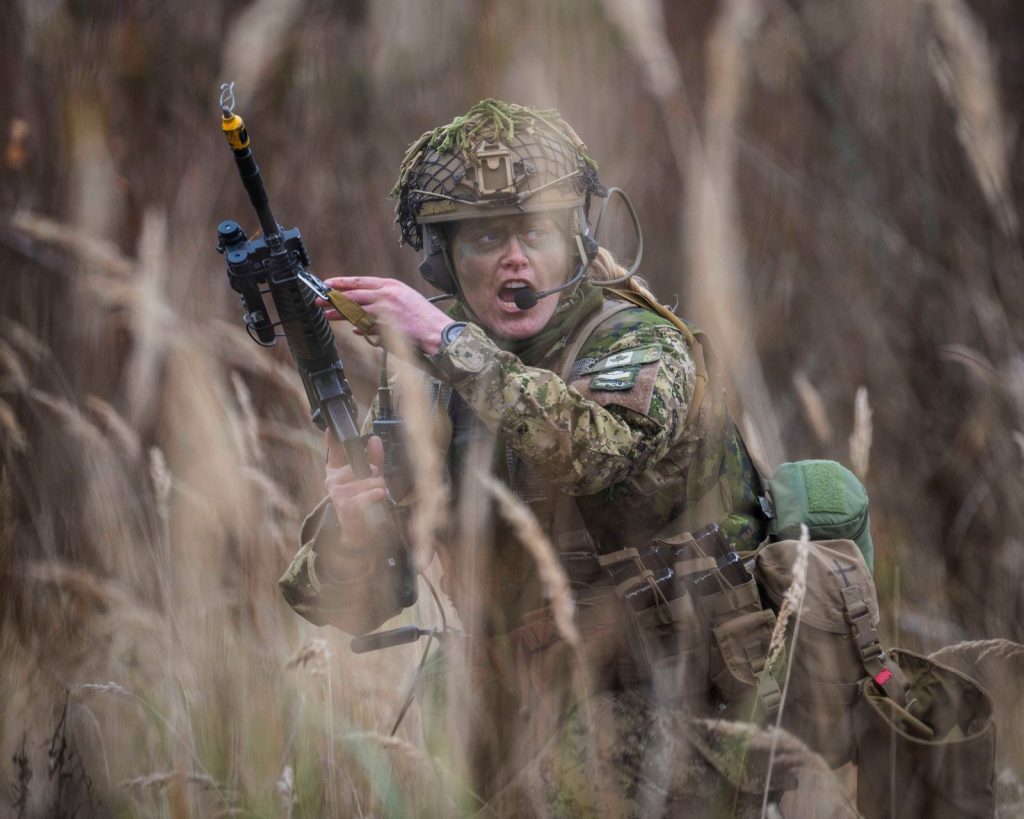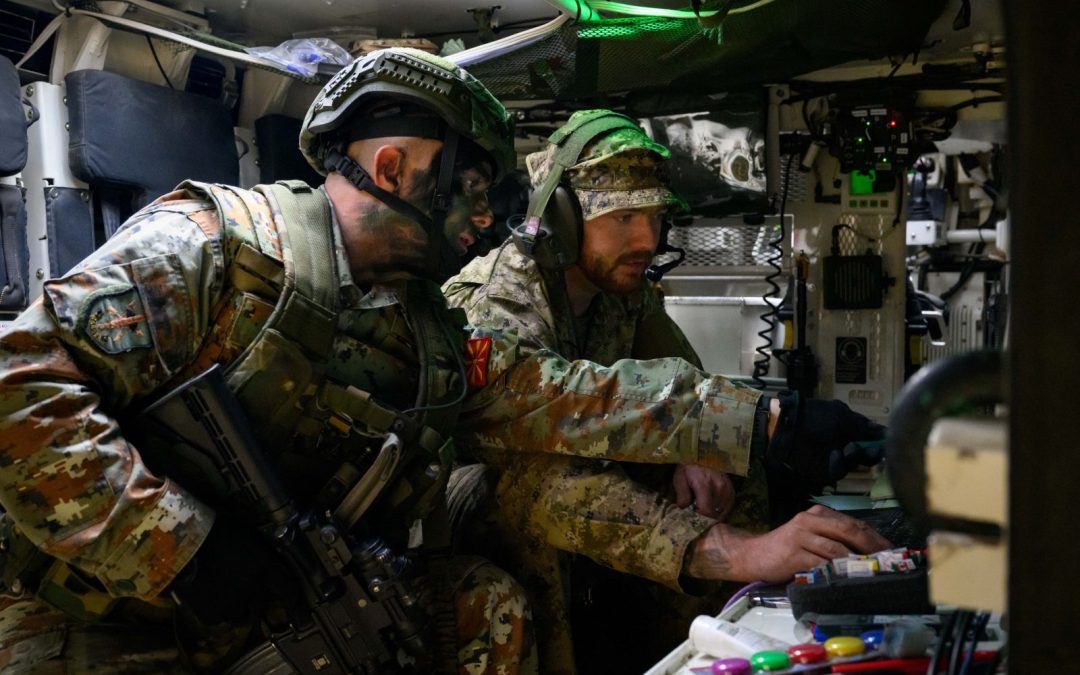by Chris Thatcher
The road to a Brigade Tactical Network (BTN) in Latvia runs through the varied terrain of the Petawawa training area and the back lot and offices of 2 Canadian Mechanized Brigade Group Headquarters and Signal Squadron (2 CMBG HQ & Sig Sqn).
Over the past two years, the squadron has conducted a series of exercises to counter a glaring reality in the modern battlespace: Anything concentrated and emitting, like a command post, is a highly vulnerable target.
Leaning heavily on the expertise of industry partners, 2 CMBG HQ & Sig Sqn developed a concept for dispersed command-and-control (C2) that emphasizes rapid mobility without sacrificing connectivity.
The Signal squadrons at all three CBMGs conducted experimentation critical to the development of the BTN, acquired as an urgent operational requirement (UOR) for command-and-control of the Canadian-led multinational brigade and battlegroup in Latvia. 5 CMBG in Valcartier was an early adopter of a Cloud TAK environment for command and control, while 1 CMBG in Edmonton led the initial exploration of Android Tactical Assault Kit (ATAK), a suite of software enabling information sharing layered over geospatial data.
But 2 CMBG HQ & Sig Sqn was the proponent of experimentation in collaboration with industry that sparked the integration of many of the components now resident in the BTN – Trellisware radios and the TSM waveform, Persistent Systems MPU5 mobile ad-hoc networking (MANET) radios, various Ultra Intelligence & Communications Orion radios, L3Harris AN/PRC-163 multi-channel handheld radios, variable height antennas, among others.
“In a short amount of time, through our work with DLCSPM (Director Land Command System Program Manager) and input from multiple brigades, we’ve been able to provide the Canadian Army with capability for positional awareness, a common operating picture, a full suite of battle management software applications, that – outside of Latvia – they currently don’t have fielded,” explained Steve O’Brien of General Dynamics Mission Systems–Canada, the systems integrator for the Army’s Land Command Support System, and the integrator on the exercises and in Latvia for the many hardware and software systems.
The former Master Warrant Officer noted that many of the components are not yet “institutionalized in the Canadian Armed Forces (CAF)” and typically would have taken years to procure. “By being so closely integrated with the Army, and then that work becoming the Latvia solution, it really pushed things out the door quickly,” he said. “In a year and a half, we had this system ready to go to Latvia, where normally, approvals would have taken much, much longer.”
Much of the credit lies with Major Nicolas Gonthier, who served as the commanding officer of 2 CMBG HQ & Sig Sqn until July. Recognizing the devastating impact on command posts observed during the early stages of Russia’s 2022 invasion, he and Colonel Jay MacKeen, at the time the commander of 2 CMBG, embraced the Canadian Army’s new digital strategy, prioritizing greater unit-level innovation and experimentation.
Through a series of live and computer-assisted exercises that began with Hermes Reach in October 2022, and continued through 2023 and into 2024, the squadron rapidly evolved a concept for a dispersed command post (CP).
With each iteration, the networking architecture, hardware, and software suite were enhanced, integrated, and further refined. Industry partners contributed not only the latest versions of their technologies and products, but, in some cases, also provided the engineering expertise behind their development.
“In just 18 months, we evolved an initial concept into a scalable, digitized, and dispersed Command Post, utilizing armored vehicles with integrated edge computing, resilient communication bearers, and headquarters staff operating in a tactical environment,” Gonthier said.
In early May in Petawawa, all that effort was consolidated into a coherent, scalable and deployable architecture in a final validation exercise named Ex Hermes Forge. The exercise also leveraged a parallel event named Ex Vigilant Mercury, a validation exercise of the CP TOPAZ communications suite for the LAV 6 conducted by 1st Battalion, the Royal Canadian Regiment and supported by Director Land Communication System Program Management.
Ex Hermes Forge had two distinct lines of efforts: Validating the dispersed and digitized CP C4ISR architecture, and fully integrating digital capabilities across the battlefield into a single data environment, from the dismounted soldier with their Integrated Soldier System (ISS), the armoured platforms with CP TOPAZ and the dispersed CP.
Over the course of the exercise, the emphasis became as much about the tactics, techniques and procedures (TTP) of operating in a dispersed manner as the network environment.
“This is a new employment concept for the brigade headquarters, and we have to develop new tactics and procedures to operate in such a way,” Gonthier observed. “Between the headquarter staff and the Sig Sqn, we’ve been drilling down the TTPs to move the dispersed CP clusters, the deployment drills within a hide, and their sustainment.”

Major Nicolas Gonthier
Instant feedback
The need to involve industry directly in the experimentation process was one of the squadron’s early and critical insights. Gonthier wanted young soldiers to see the next generation of technology they were using — and at times struggling with. He also recognized that industry partners could help the squadron understand its next bound of technology requirements and challenges.
But even he underestimated the benefits of those interactions between soldiers and industry representatives.
More than 12 companies and their 70 representatives, engineers and contractors participated over the two years. In addition to General Dynamics, Interop and Ultra Communications, the list included teams from Persistent Systems, Hoverfly, Trellisware, Systematic, Allen Vanguard, L3Harris, Base Camp Connect, and Rheinmetall.
2 CMBG HQ & Sig Sqn had no pool of funding or access to Directorate of Land Requirements (DLR) projects, so it was understood from the outset that the opportunity for vendors was purely experimentation. But the exercises gave industry tactical exposure and feedback on how soldiers use their capabilities, and provided signalers direct access to the engineers who designed and built the hardware and software they were trialing.
“The direct mentorship from senior company engineers and field service reps, who understand fully the extent of their capabilities, was an invaluable learning experience for the troops,” Gonthier noted.
One of the early realizations was that the Army did not always use its equipment and systems to their full potential. “We told them, you’ve already bought it, but you can do much more,” Denis Couillard, a former CAF member and director of Solutions Development for Ultra Communications, said of the Orion X500 radio. The two channel software defined radio, widely used by the U.S. Army, enables point-to-point, point-to-multipoint, and point-to-mesh communication in three different bands. Canada was “only using a portion of that.”
“Nobody is gaining by having the soldier not fully understand a capability,” Gonthier added.
The series of exercises enabled Signallers to become better acquainted with their existing systems, but they also provided a path to resolve technical issues collaboratively with industry before a capability is deployed.
That ran true for the team of Charlie Troop staffing the network operations centre (NOC) on Ex Hermes Forge. A troubleshooting centre for network, radio and vehicle issues, the NOC served as the nexus between the Army’s technicians and industry representatives.
In a traditional exercise or operation, the NOC would receive the “trouble” tickets and dispatch uniformed technicians to resolve the issue. On this exercise, they were “bridging resources,” said Lieutenant Julien Leclerc, the officer commanding, and connecting techs with the appropriate industry field representative.
By the second week, they had pivoted to a three-layer helpdesk approach, explained Sergeant Kyle Ladouceur. If an issue arose with a system, the operator on the ground first tried to troubleshoot; if that failed, the NOC dispatched a Signals technician; and if the issue persisted, an industry engineering team joined the effort.
“The amount of learning that our techs are able to get from the [company] engineers who are developing the capability has been phenomenal,” said Leclerc. “On the flip side, [companies] are getting a lot of feedback directly from the system managers they will be delivering the capability to, i.e., soldiers.”
Ex Hermes Forge was the first time some systems were integrated, so balancing the technical validation with the tactical validation — how a cluster of vehicles moves and disperses, reducing its radio frequency signature while remaining networked — was a challenge, said Leclerc. “We are trying to juggle both at once.”
“It’s a giant learning process for everybody,” added Ladouceur, noting that soldiers are often handed a piece of equipment and instructed how to use it. In building the dispersed CP, they were enjoying the opportunity “to be part of the development.”

Photo: Cpl Sébastien Lauzier-Labarre
Not the enemy
“Exercises like these have become the lab in a sense and by engaging a broad base of Canadian industry, we’re really working collaboratively to enable the Army to leverage the latest capabilities and solutions, faster,” observed O’Brien.
To maximize the opportunity, General Dynamics brought its “multidisciplinary teams into the field so they get to see the products in use and hear the requirements directly from the soldiers. They also get to see what the other OEMs need for their products to be integrated,” he said. “It helps us get more real world, meaningful feedback.”
“I hope [the experimentation] continues because I think that is something in the U.S. they do very well,” said Jim Peter Safar, president and founder of Interop Canada, which focuses on next-generation tactical communications and works extensively with U.S. Special Operations Command and the U.S. Army. “Industry is not the enemy … We have a lot of knowledge for the customer to leverage, and I think that Canada is starting to change that mentality and look at us as a partner.”
Interop provided Trellisware radios and the TSM waveform, effectively an interoperability waveform for third-party radios. It is also a partner with Hoverfly, a drone manufacturer, and provided a variable height antenna — a 200-feet tethered drone with an Orion radio — to enable a software defined channel as a bearer between rear headquarters and the dispersed CP.
The exercises were a demonstration of what is possible when the Army and industry collaborate to solve difficult problems, said Safar, and gave industry a firsthand opportunity to understand the challenges of integrating hardware into large vehicles. “We don’t get to have hands on Bisons and LAVs, and it is quite a learning curve to see how much is in those vehicles.”
Keith Blanchet, vice president of Business Development for Ultra I&Cs’ Communications division, suggested that “what happened in Canada over the last two years was very special.” The U.S. Army may have more experimentation events for industry, but it is a large machine. By stepping outside of the box, 2 CMBG HQ & Sig Sqn showed “we’re able to do this faster and very intelligently, with a lot of innovation.”
Moreover, participation in the Army’s training events “creates energy,” he emphasized. “We like to see our systems operating, sometimes failing, then adapting and succeeding.” Unlike a paper or tabletop exercise, “we feel we are getting somewhere.”
Gonthier doesn’t want to lose that momentum. Well planned experimentation can de-risk the development and introduction of new versions of a technology, flagging when a capability might be on the wrong track, he noted. And that could be important as the Army adopts a continuous capability sustainment approach of regular spirals to refresh technology.
“Doing rapid iteration brings a level of chaos that is uncomfortable, but necessary. We must be able to test prototypes, formalize lessons learned, and identify how we are going to operationalize the ideas and capabilities that bring the most value,” he said. One of his recommendations is an exercise in the brigade’s build phase to deployment, no less than once every two years.
The Signals community needs its practitioners to become true professionals of the newest systems, suggested Chief Warrant Officer Ray Laplante, the Regimental Sergeant Major, who retired in September. A 30-year veteran with deployments in Rwanda, Haiti, Afghanistan, Iraq and Latvia, he argued that soldiers become somewhat expert on the current equipment, “because that’s all we have. I think we need to get better at using newer equipment much sooner and being professional at that. And we need to become a bit better at innovating ourselves.”
The Canadian Forces School of Communications and Electronics is now working on modernizing its curriculum and “bringing third-party contractors to do part of the teaching,” said Gonthier. “Just at the unit, we’re investing a lot of funding per year just so Signallers can keep up with the latest technology.”

A member from PPCLI issues orders during the advance on Jelgava Air Base, EXERCISE RESOLUTE WARRIOR, Jelgava, on 06 November 2024. Photo: Multinational Brigade Latvia Imagery
Rapid prototyping
“We are still working through a bunch of kinks,” acknowledged Master Corporal Kyle Bezemer, in command of a link node in one of a cluster of vehicles on Ex Hermes Forge. Every time the vehicles relocated to a new position, something that was working well now seemed to be offline.
In the back of the Bison, two techs were working on the TSM and MPU5 radios as another two soldiers assembled a quick-erect mast. The antenna was one of several capabilities prototyped for the dispersed CP concept. Ultra Communications tapped the manufacturer of the Army’s original 17 metre mast, which had not been modified in 15 years. Using a bracket on the Bison, an engineer came up with an 18m to 21m mast that is 42 pounds lighter and can support up to a 20-pound radio. More important, it can be winched up in minutes and cut lose in seconds if the Bison needs to exit a location quickly.
As the other vehicles in the cluster, dispersed among the trees along a narrow dirt roadway, waited on his communication node, Bezemer noted the security of operating from a protected vehicle rather than the usual tent that could be “a giant beacon.” In learning how to operate as a dispersed CP, “we have been able to minimize our footprint,” he said.
That, ultimately, is the crux of the dispersed concept: Communicating data and decisions with as small a footprint and signature as possible.

